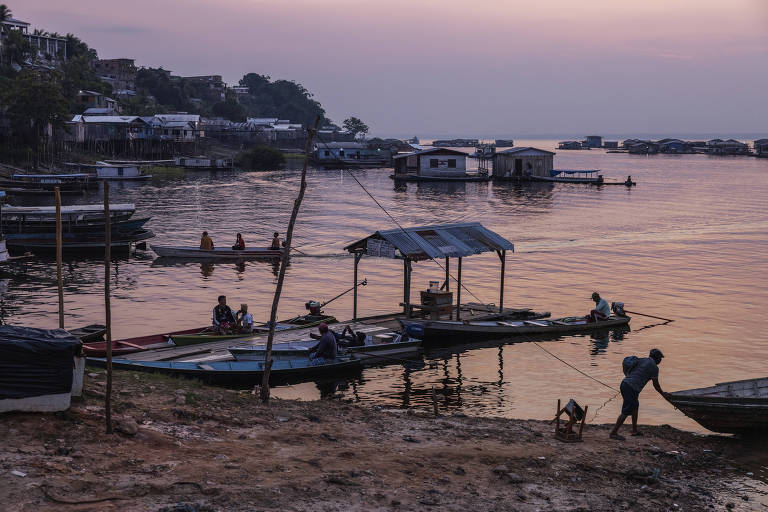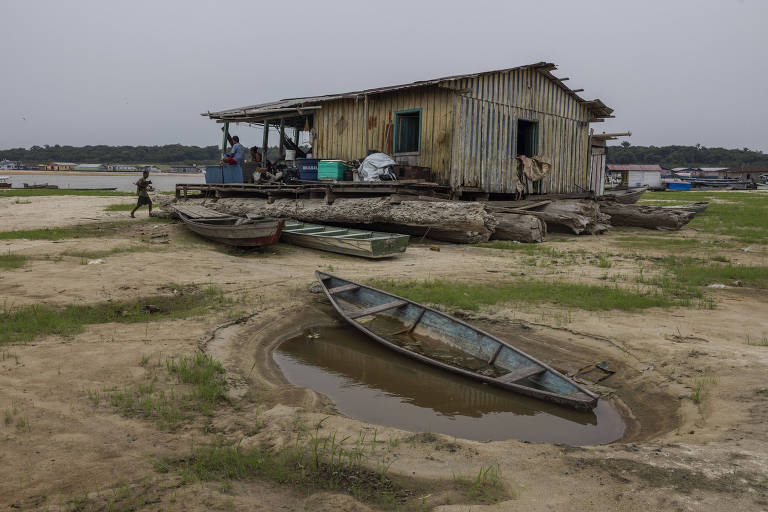Solimões River is converted into desert in the Amazon – 10/15/2023 – Environment
[ad_1]
The Solimões River is a central vein of the Amazon. It carries ancestry, connects regions and countries, gives life to a multitude of traditional communities on its banks and on the banks of tributaries and streams.
The stretch that borders the Porto Praia de Baixo Indigenous Land, in the region of Tefé (AM), has turned into a desert. The raging river, which dictated the rhythm of the community, was replaced by huge sandbanks as far as the eye could see.
Kokamas, tikunas and mayorunas cross these sandbars from bank to bank, from end to end of the indigenous land, in an image that resembles a desert.
The transformation is an extreme situation: the indigenous people of Porto Praia are unanimous in pointing out the 2023 drought as the worst ever seen, surpassing the effects of the 2010 drought.
Solimões River suffers from drought
In 2022, the waters of the Solimões River reached the Porto Praia Indigenous Land, in the Médio Solimões region; a year later, the bed is dry – Lalo de Almeida – 13.out.23/Folhapress
The river has dried up a lot, the sandbanks are more extensive, boats anchor further and further away, the drought has lasted longer and the expectation is that this desert scenario will continue until November.
“We have to get these boats out of here today, otherwise everything will be stuck tomorrow”, said one of the indigenous people of Porto Praia this Friday (13), in relation to around 30 boats parked in front of the community. “The river keeps going down,” he says.
A Sheet He was in indigenous land for the first time on August 23, 2022. It was the beginning of the drought, which proved to be severe last year, but there was a river in the place. “We were still fishing well in September”, recalls a member of the community. Sandbanks only formed in October of that year.
In 2023, the scenario is different — and the transformation has dramatic contours. The river dried up in September, and water levels decrease every day, with no end in sight.
In 2022, getting to the territory was simple: 30 minutes by boat from Tefé to the community access stairs. Now, boats only reach two kilometers from the village. You have to walk along the muddy riverbank. Another possible route is along the sandbanks, bypassing pools of water that resist drought.
“It’s all very sad. There’s no way to go fishing, or take our products to sell in the city”, says chief Amilton Braz da Silva Kokama, 52. The more than 100 families in the territory produce mainly flour and bananas.
The indigenous people improvise small dredges, trying to make way for the water and the boats. It works very little. Every day, there is less water.
The desert that has formed is crossed by those who insist on fishing in a lake beyond the opposite bank. Or by carriers of city products and boat engines left kilometers away from the community.
The fear is that the engines will be stolen by pirates, common in Solimões. They continue to operate even in severe drought.
The reporter was in Porto Praia in 2022 for a series on undemarcated indigenous lands, as is the case with the territory.
The indigenous people made a self-demarcation, as a form of protection against invaders, especially illegal loggers and fishermen, and set up a guard to monitor and combat the activities of pirates in Solimões.
Just over a year later, the conversion of a river into a desert changed the scale of concerns in the community.
“The fish mortality was huge, unlike the 2010 drought,” says the chief. “It didn’t ‘close’ like that here. There were deeper wells.”
An artesian well guarantees water consumption by families. Porto Praia insists on getting around isolation: the indigenous people try to access lakes for fishing and the city of Tefé, where they sell their products. The river continues to ebb, an indication that the drought will continue to advance at this point in the Solimões.
The reality in the Nova Esperança do Arauiri village, on the Boará/Boarazinho Indigenous Land, is also one of isolation — the Paranã do Arauiri stream has become a narrow watercourse, with stagnant, heated, muddy and fetid water. Vessels no longer reach Solimões. To get to the village you have to walk two kilometers along an improvised trail in front of the dryness of the stream.
Nova Esperança experiences a chronic water shortage. Until a month ago, the community had no alternative but to use the muddy water from the stream. The result was a “pandemic” — a word used by chief Cláudio Cavalcante, 44 — of diarrhea, vomiting, fever and stomach pain, especially among children.
Houseboats are stranded
The floating houses on the Solimões River were still floating last year, but this year they are stranded in front of the city of Tefé – Lalo de Almeida – 12.out.23/Folhapress
The installation of solar panels last month allowed water to be pumped from a nearby lake, but the quality remains poor. According to the chief, there was no training so that families could treat and filter the water, which is also collected from the sparse rains during the drought.
Health problems arising from the consumption of this water continue. When the report was in the community, four people were sick with diarrhea.
When contacted, the government of Amazonas, the city of Tefé and Funai (National Foundation of Indigenous Peoples) did not respond until the publication of this report.
Civil Defense brought drinking water to the 17 kokama families in Nova Esperança, but in insufficient quantity.
“Urgently, we need water, training for treatment and medicines for diarrhea, intestinal infections and vomiting”, says Cavalcante. The chief predicts an even longer drought: the river will only be navigable at the end of November. “The 2010 drought wasn’t as difficult as this one. This is certainly the worst we’ve ever had here.”
The shrinking of the stream prevents the transport of corn, bananas and watermelons cultivated by the indigenous people to Tefé. “The sun was so hot in this region that it damaged the plantation. It dried up the watermelon plantation,” says Cavalcante.
Without water to drink, it was necessary to stop children’s classes. Nothing is more urgent in the village than the search for a solution so that families have drinking water during the drought.
“We suffer from the ‘pandemic’ of these diseases every year. But this year it was worse, it started in August”, says the chief. “We can’t treat the water.”
[ad_2]
Source link










